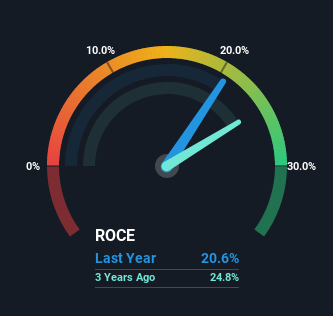Returns On Capital At Balrampur Chini Mills (NSE:BALRAMCHIN) Paint A Concerning Picture

What are the early trends we should look for to identify a stock that could multiply in value over the long term? Typically, we'll want to notice a trend of growing return on capital employed (ROCE) and alongside that, an expanding base of capital employed. This shows us that it's a compounding machine, able to continually reinvest its earnings back into the business and generate higher returns. So when we looked at Balrampur Chini Mills (NSE:BALRAMCHIN), they do have a high ROCE, but we weren't exactly elated from how returns are trending.
What is Return On Capital Employed (ROCE)?
If you haven't worked with ROCE before, it measures the 'return' (pre-tax profit) a company generates from capital employed in its business. The formula for this calculation on Balrampur Chini Mills is:
Return on Capital Employed = Earnings Before Interest and Tax (EBIT) ÷ (Total Assets - Current Liabilities)
0.21 = ₹5.9b ÷ (₹31b - ₹2.9b) (Based on the trailing twelve months to December 2021).
Thus, Balrampur Chini Mills has an ROCE of 21%. In absolute terms that's a great return and it's even better than the Food industry average of 13%.
View our latest analysis for Balrampur Chini Mills

Historical performance is a great place to start when researching a stock so above you can see the gauge for Balrampur Chini Mills' ROCE against it's prior returns. If you're interested in investigating Balrampur Chini Mills' past further, check out this free graph of past earnings, revenue and cash flow.
The Trend Of ROCE
When we looked at the ROCE trend at Balrampur Chini Mills, we didn't gain much confidence. To be more specific, while the ROCE is still high, it's fallen from 36% where it was five years ago. And considering revenue has dropped while employing more capital, we'd be cautious. If this were to continue, you might be looking at a company that is trying to reinvest for growth but is actually losing market share since sales haven't increased.
On a side note, Balrampur Chini Mills has done well to pay down its current liabilities to 9.2% of total assets. So we could link some of this to the decrease in ROCE. Effectively this means their suppliers or short-term creditors are funding less of the business, which reduces some elements of risk. Some would claim this reduces the business' efficiency at generating ROCE since it is now funding more of the operations with its own money.
What We Can Learn From Balrampur Chini Mills' ROCE
We're a bit apprehensive about Balrampur Chini Mills because despite more capital being deployed in the business, returns on that capital and sales have both fallen. The market must be rosy on the stock's future because even though the underlying trends aren't too encouraging, the stock has soared 214%. Regardless, we don't feel too comfortable with the fundamentals so we'd be steering clear of this stock for now.
Balrampur Chini Mills does have some risks, we noticed 2 warning signs (and 1 which shouldn't be ignored) we think you should know about.
Balrampur Chini Mills is not the only stock earning high returns. If you'd like to see more, check out our free list of companies earning high returns on equity with solid fundamentals.
Valuation is complex, but we're here to simplify it.
Discover if Balrampur Chini Mills might be undervalued or overvalued with our detailed analysis, featuring fair value estimates, potential risks, dividends, insider trades, and its financial condition.
Access Free AnalysisHave feedback on this article? Concerned about the content? Get in touch with us directly. Alternatively, email editorial-team (at) simplywallst.com.
This article by Simply Wall St is general in nature. We provide commentary based on historical data and analyst forecasts only using an unbiased methodology and our articles are not intended to be financial advice. It does not constitute a recommendation to buy or sell any stock, and does not take account of your objectives, or your financial situation. We aim to bring you long-term focused analysis driven by fundamental data. Note that our analysis may not factor in the latest price-sensitive company announcements or qualitative material. Simply Wall St has no position in any stocks mentioned.
About NSEI:BALRAMCHIN
Balrampur Chini Mills
Engages in the manufacture and sale of sugar in India.
Reasonable growth potential and fair value.
Market Insights
Community Narratives



